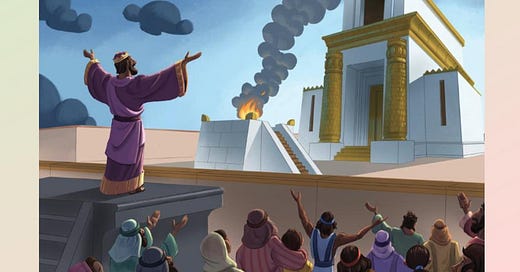Unveiling the Meaning of the Temple
Monday, Feb 5, 2024 - Memorial of Saint Agatha, Virgin and Martyr
From the Mount of Olives, you can see across the Kidron Valley the Dome of the Rock standing atop the Temple Mount. Beneath this iconic Muslim shrine, historical evidence and archaeological findings indicate that the Temple of Solomon may have been built on the same ground. Today, in our reading we witness the transfer of the Ark of the Covenant and other objects needed for worship from a tent to the first Temple. The dedication of the Temple took place in the seventh month during which the Jewish people celebrate their three most significant feasts: the New Year, the Day of Atonement, and the Feast of Tabernacles.
The narrative of the dedication of that first temple in Jerusalem leads me to explore the different meanings of the word “temple” in the Bible. This word signifies a place where the Lord dwells among his people. Thus, the first temple in the Bible is the world created by God with its threefold structure: the garden in Eden, the earth, and the sea. The purpose of creating the sun, the moon, and the stars was to enable the people to know on which days they were supposed to worship the Lord. Even today, we follow the lunar calendar to establish the dates of the celebration of Passover and Easter.
The next 'temple,' where the Lord dwelled among his people, was the portable Tent built by Moses in the desert. Upon the completion of the making of that temple “the glory of the LORD filled the tabernacle” and “Moses was not able to enter” it (Exod. 40:34-35). A similar statement describes the dedication of Solomon’s temple: “A cloud filled the house of the LORD so that the priests could not stand to minister because of the cloud, for the glory of the LORD filled the house of the LORD” (1 Kings 8:10-11).
As we transition to the New Testament, the word “temple” gets a new meaning that does not refer anymore to physical structures but to the human body. We are all familiar with Jesus’ statement in John’s Gospel: “Destroy this temple, and in three days I will raise it up” (John 2:19). The Evangelist explains to us that Jesus “was speaking about the temple of his body” (John 2:21). In the apostolic letters God’s temple is built of those who believe in Christ. Saint Peter describes believers as 'living stones' built into a spiritual temple. (1 Peter 2:5). Saint Paul states that we, as the community of the Church, are God’s temple (1 Cor 3:16) and that our bodies are also the temple of the Holy Spirit (1 Cor 6:19-20).
The meaning of “temple” as the dwelling place of the Lord among his people encapsulates the meaning of God’s intention for humanity and its final fulfilment in a new creation. The final dwelling place of God with his people is described as a city called “New Jerusalem”. No temple shall be found in that city “for its temple is the Lord God the Almighty and the Lamb” (Rev 21:22).




